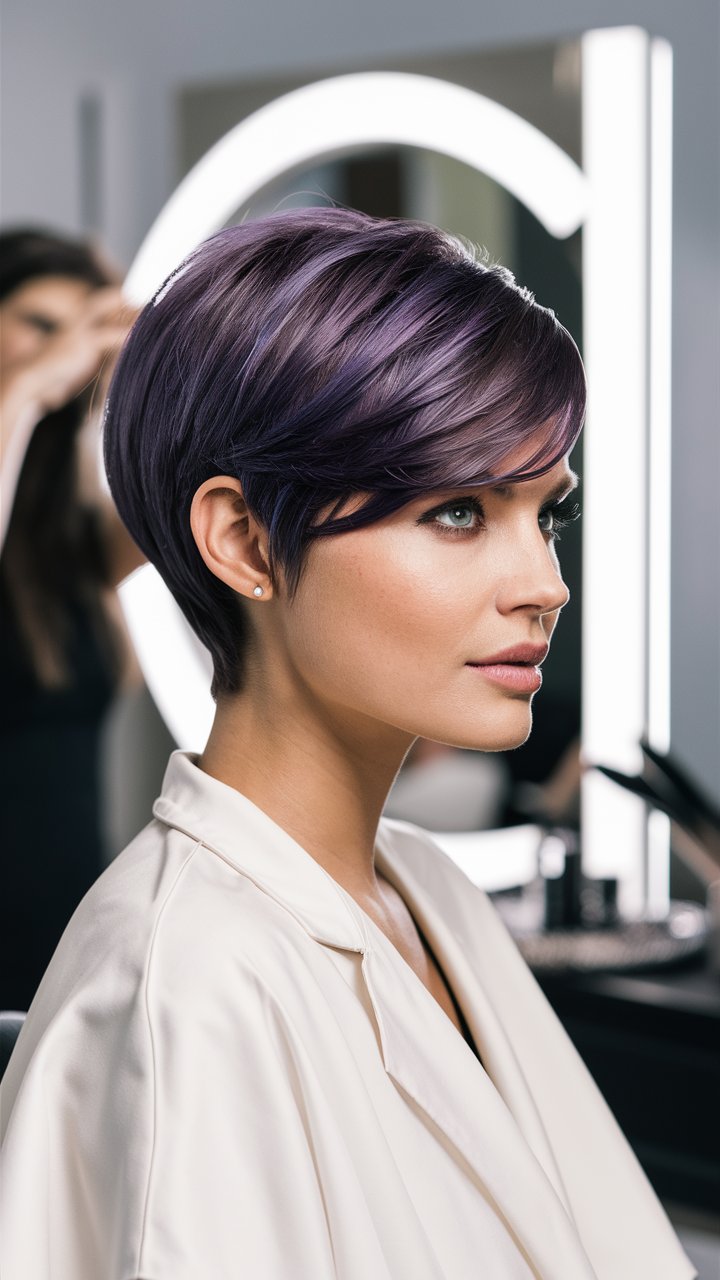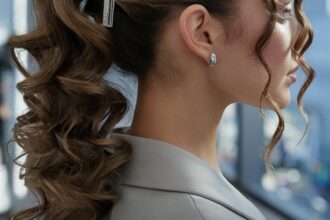Introduction: The Power of the Perfect Short Haircut
There’s something undeniably powerful about a well-chosen short haircut. It can define your personality, complement your lifestyle, enhance your features, and even boost your confidence. But one question often stops many people from making the chop:
What type of hair do you need for a short hairstyle?
The answer is both simple and complex: almost every hair type can suit a short hairstyle—if it’s the right one for your unique texture, density, and styling needs. Whether your hair is straight, wavy, curly, fine, coarse, or somewhere in between, there’s a short haircut that can work beautifully for you.
This guide will help you understand:
- Which short styles suit different hair types
- How to enhance your natural texture
- What to avoid based on your hair’s traits
- Styling tips to maintain your cut effortlessly
Let’s dive into the details.
Chapter 1: Understanding Hair Types – Texture, Density, and Behavior

Before picking a short hairstyle, you need to know your hair inside and out. Hair type isn’t just about whether it’s straight or curly—it’s about how thick each strand is, how dense your hair is overall, and how your hair behaves in various conditions.
1.1 Hair Texture Categories
- Straight Hair (Type 1): Flat, sleek, lacks natural curl or wave.
- Wavy Hair (Type 2): Falls between straight and curly, often has S-shapes.
- Curly Hair (Type 3): Defined ringlets or coils; tends to be drier and prone to shrinkage.
- Coily/Kinky Hair (Type 4): Tight curls or zig-zag coils; very dense and fragile.
1.2 Hair Density
- Fine Hair: Thin strands, prone to looking flat or limp.
- Medium Hair: Balanced thickness, holds styles well.
- Thick Hair: Abundant volume, may be heavy or frizzy.
Understanding your texture + density helps you choose a short haircut that works with, not against, your natural hair.
Chapter 2: Best Short Hairstyles by Hair Type
Now, let’s match your hair type with the best short styles tailored to your natural look.
2.1 Short Hairstyles for Straight Hair
Hair Traits: Straight hair lies flat, reflects light easily, and can appear sleek or limp depending on the cut.
Best Short Hairstyles:
- Blunt Bob: Sharp and defined, ideal for fine to medium straight hair. Adds structure and style without much effort.
- Asymmetrical Bob: Slightly longer on one side; works for those who want movement without layers.
- Pixie Cut with Tapered Sides: Sleek, clean, and edgy. Great for a low-maintenance, fashion-forward look.
Styling Tips:
- Use volumizing mousse or dry shampoo to lift roots.
- Try a smoothing serum for a glassy finish.
Avoid: Over-layering, which can make straight hair look stringy or flat.
2.2 Short Hairstyles for Wavy Hair
Hair Traits: Natural wave pattern, moderate volume, often frizz-prone in humidity.
Best Short Hairstyles:
- Textured Lob (Long Bob): Hits around the collarbone; enhances waves while giving you room to style.
- Shag Cut: Layers that add movement, volume, and playful texture.
- Beachy Bob: Chin-length or above, with minimal structure. Perfect for an effortless vibe.
Styling Tips:
- Use sea salt spray or mousse to enhance your natural wave pattern.
- Scrunch hair gently and air dry for a casual finish.
Avoid: Razor cutting, which can promote frizz and uneven ends.
2.3 Short Hairstyles for Curly Hair
Hair Traits: Defined curls or coils, naturally voluminous, can shrink when dry.
Best Short Hairstyles:
- Curly Shag: Layers throughout with curtain bangs; gives dimension and keeps curls bouncy.
- Tapered Afro: Short sides and back, with volume on top. Structured but playful.
- Curly Bob: Chin-length or shoulder-grazing, shaped to your curl pattern.
Styling Tips:
- Use curl creams, defining gels, or leave-ins to hydrate and control frizz.
- Avoid brushing—detangle with your fingers or a wide-tooth comb.
Avoid: Very blunt cuts or heavy bangs that disrupt curl patterns.
2.4 Short Hairstyles for Thick Hair
Hair Traits: Full, voluminous, may feel heavy or frizzy without product.
Best Short Hairstyles:
- Graduated Bob: Shorter in back, longer in front. Reduces bulk and adds style.
- Layered Pixie Cut: Short with structured layers to control thickness.
- Undercut: Shaves the underside for reduced bulk and bold contrast.
Styling Tips:
- Use smoothing serums and hydrating masks to reduce puffiness.
- Consider thinning shears for shaping without volume overload.
Avoid: One-length cuts—they can appear overly bulky and lose shape fast.
2.5 Short Hairstyles for Fine Hair
Hair Traits: Thin strands, can lack body and volume.
Best Short Hairstyles:
- Pixie Cut with Bangs: Short length enhances volume; bangs add interest.
- Blunt Cut Bob: Gives illusion of density and structure.
- Stacked Bob: Shorter in the back with layers for a fuller look.
Styling Tips:
- Use volumizing products like root lifters or lightweight mousse.
- Blow dry upside down to add lift at the crown.
Avoid: Over-layering—can make fine hair look even thinner.
Chapter 3: Face Shape vs. Hair Type – Finding the Perfect Match
Hair type matters—but so does face shape. Here’s a quick guide to matching both:
| Face Shape | Best Short Styles | Avoid These |
|---|---|---|
| Round | Asymmetrical cuts, long pixies | Full bobs that add width |
| Oval | Most short cuts | Overly long front-heavy styles |
| Square | Soft layers, wavy bobs | Boxy or very blunt cuts |
| Heart | Side-swept bangs, pixies with volume | Very short blunt fringes |
| Long | Chin-length bobs, waves | Long layers that elongate further |
A good stylist will always consider both your hair type and face shape to craft the ideal cut.
Chapter 4: Lifestyle and Short Hair – What to Consider
Before you commit to short hair, ask yourself:
- How much time can I spend styling?
Some styles require heat tools or curl management daily. - Do I use hair products regularly?
Short styles usually need product to maintain shape or texture. - What’s my climate?
Humid areas can affect frizz or curl behavior dramatically. - Am I open to regular trims?
Short hair requires upkeep every 4–6 weeks for best results.
Short hair can be freeing—but it comes with its own rhythm and care routine.
Chapter 5: Products and Tools for Every Hair Type
To maintain your short style, these are the must-haves tailored to each type:
For Straight Hair:
- Smoothing Serum: Controls frizz and flyaways.
- Flat Iron: Helps define sleek styles.
For Wavy Hair:
- Texturizing Spray: Enhances movement.
- Diffuser Attachment: Defines waves when blow drying.
For Curly Hair:
- Curl Cream/Gel: Adds definition and moisture.
- Microfiber Towel: Reduces frizz after washing.
For Thick Hair:
- Anti-Frizz Serum: Keeps shape and shine.
- Layering Scissors (for stylists): Helps thin out excess bulk.
For Fine Hair:
- Volumizing Mousse: Adds body at roots.
- Dry Shampoo: Great for lift and oil control between washes.
Chapter 6: Tips to Maintain Short Haircuts Long-Term
- Trim regularly: Short styles lose shape fast; trim every 4–6 weeks.
- Wash less, style more: Short hair may not need daily washing. Use styling sprays and dry shampoos.
- Don’t skip conditioner: Even short hair needs hydration—choose lightweight formulas.
- Switch up parts: Changing your part occasionally adds volume and prevents flattening.
- Consult your stylist: They can recommend cuts and products based on your hair’s growth and behavior.
Conclusion: Embrace the Cut That Complements You
There’s no one-size-fits-all short haircut—but there is one that fits you. By understanding your hair type, density, face shape, and lifestyle, you can confidently choose a short style that enhances your natural beauty rather than fights against it.
The beauty of short hair lies in its versatility, boldness, and practicality. Whether you’re a curly-haired free spirit, a sleek straight-hair lover, or a thick-haired volume queen—there’s a powerful short cut ready to define your next chapter.
So go ahead. Make the chop. Make the statement.





